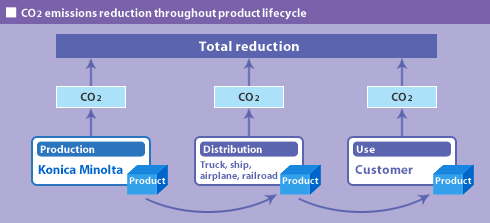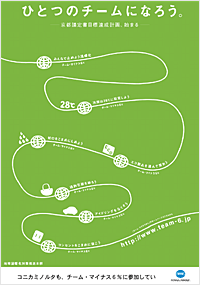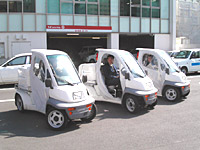Global Warming Prevention

Concepts for Preventing Global Warming -- CO2 Reduction throughout Product Lifecycle --
Helping to prevent global warming is one of the most important social responsibilities of the manufacturer today. The Konica Minolta Group is committed to helping prevent global warming from an overall product lifecycle perspective.
Our measures for reducing CO2 emissions cover not only emissions from our business sites during product manufacture, but also during product distribution and use at the customer's site.
On the basis of this concept, Konica Minolta has established a challenging target: a 20% reduction in CO2 emissions by fiscal year 2010 as compared to the 2000 level throughout the product lifecycle, from production and distribution to use. To ensure that we achieve this goal, reduction targets have been set for the following four parameters: CO2 emissions from sites in Japan; from manufacturing sites in the U.S., Europe, and Asia; during distribution; and during product use.

Reduction of CO2 Emissions from Business Sites
In February 2005, the Kyoto Protocol took effect. Corporate responsibility for reducing CO2 emissions from business sites has increased accordingly. Konica Minolta has established a challenging target: ”a 7% reduction of CO2 emissions from Group business sites in Japan by fiscal year 2010, as compared to fiscal 1990 levels“, which is even more stringent than the 6% reduction target Japan must meet under the Kyoto Protocol. We have also set another target, ”a 7% reduction of CO2 emissions from Group manufacturing sites in the U.S., Europe, and Asia by fiscal 2010, as compared to fiscal 2000 levels,“ so as to globally redouble our energy-saving efforts. To achieve these targets, each business company has set out its own targets per unit of production or other operational measure, thus promoting initiatives directly aligned with each business.
In fiscal year 2006, CO2 emissions from Group manufacturing and R&D sites in Japan decreased by 5.7% as compared to the previous year (16.2% increase from 1990 levels). CO2 emissions from manufacturing sites in the U.S., Europe, and Asia decreased by 3.4% from the previous year (12.1% increase from 2000 levels). Each Konica Minolta business site works to reduce CO2 emissions by making physical improvements to utility systems, such as by replacing facilities and equipment with inverter-driven equivalents and introducing high-efficiency equipment. At the same time, respective business sites have strengthened their measures for preventing excessive air leakage and for improving production efficiency, so as to reduce CO2 emissions during production. Such efforts resulted in a reduction in CO2 emissions from the previous year. We also understand that our future plans for plant expansion and production expansion involve many factors that could increase CO2 emissions. To cover such an increase, Konica Minolta has made preparations for acquiring emission credits—as a complementary measure—in conjunction with thorough going energy-saving efforts.
From this time forward, we will globally promote the Energy-Conservation Support Program, under which experts comprehensively assess energy use at each site and identify energy-saving measures appropriate to each specific site. We will continue our all-out efforts toward energy-saving, complemented by initiatives for emission credit acquisition.

Team Minus 6%
”Team Minus 6%“ is the nickname of a national campaign waged in Japan to fight global warming by achieving the 6% reduction commitment stipulated in the Kyoto Protocol. In support of the campaign's objective, Konica Minolta has enrolled as a member of ”Team Minus 6%“ and is taking the following measures.

- 1) In-house measures
-
- Recommended air conditioning settings of 28 degree C in summer, and 20 degree C in winter
- Putting up posters to advertise Company participation in ”Team Minus 6%“ to all employees and calling for their all-out efforts.
- Promoting ”Cool Biz“ and ”Warm Biz“ campaigns to encourage employees to dress down in summer and dress warmly in winter, so as to adapt to appropriate room temperature settings.
- Efficient operation of elevators
- ”Two-up and Three-down“ campaign (use stairs, rather than elevators, when going up two floors and down three floors).
- Energy-saving on office lighting and OA equipment
- Turning off power when lights are not needed.
- Using energy-saving mode and turning off power when OA equipment is not in use.
- Promotion of idling stops
- Stopping engine idling in Company-owned vehicles when not in motion.
- Requesting vehicles entering Company premises to stop idling engines when not in motion.
- Recommended air conditioning settings of 28 degree C in summer, and 20 degree C in winter
- 2) Activities at home
- Encouraging employees to act on the ”Team Minus 6%“ campaign even at home.
- 3) Activities outside the Company
- Encouraging active participation in related campaigns and other events organized outside the Company (mainly via the Corporate Communication & Brand Management Departments).
Reduction of CO2 Emissions during Product Distribution
The Konica Minolta Group has promoted a modal shift away from long-distance trucking to transport by rail and sea. We have also been working to improve our logistical efficiency through distribution center integration, joint transportation between distribution centers, and use of the return journey from product delivery to collect used copiers and photographic developer equipment. In fiscal year 2006, we established a goal to reduce CO2 emissions during product distribution by 30% per unit of sales as compared to fiscal 2000 levels. To achieve this goal, we have accelerated our reduction efforts.
Konica Minolta Business Technologies Inc. (hereinafter referred to as ”Business Technologies“), which produces and sells information equipment, is working to minimize air transport, which involve significant CO2 emissions. Although the company usually uses ships for international transport, occasionally it has no choice but to use aircraft. Business Technologies has striven to decrease the frequency of air transport. In fiscal year 2006, the company reduced its air transport ratio by 60% as compared with 2004 levels. In addition, the company is committed to reducing CO2 emissions during distribution, by improving distribution efficiency through active reorganization of its worldwide distribution network.
Reduction of CO2 Emissions during Sales Stage
Konica Minolta Business Solutions Japan has been promoting the introduction of electric-powered vehicles. Service engineers use these vehicles when visiting customers to conduct maintenance of multifunctional peripherals (MFPs) and other equipment. Electric vehicles have less environmental impact than fossil fuel-driven vehicles, and their compact bodies afford better mobility in urban areas. Company motorcycles used for servicing purposes in Tokyo will be replaced with this type of vehicle.

Electric-powered vehicles
Reduction of CO2 Emissions during Product Use
Respective business companies have established their own goals and are working to reduce CO2 emissions during product use, with a particular focus on energy conservation. Taking MFPs as an example, CO2 released when they are in use accounts for a significant percentage of the CO2 emissions throughout their lifecycle. We are striving to reduce power consumption during the MFP's fusing process, which occupies a large proportion of power consumption when this equipment is in use. For details, please refer to the section ”Environmentally Sound Products.“

